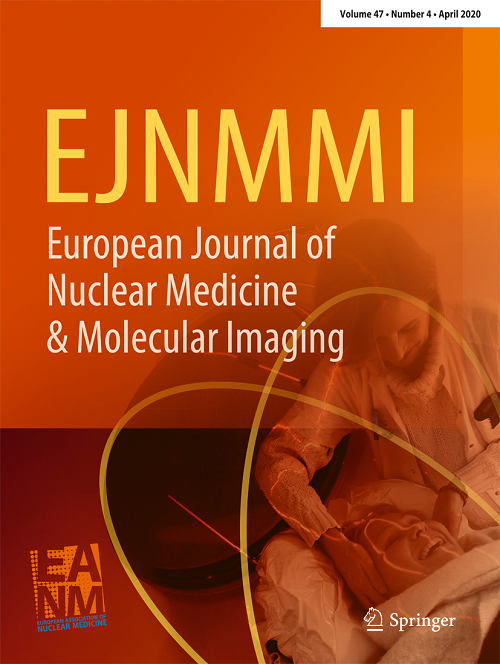18F-FDG PET/CT及增强CT对食管鳞状细胞癌患者新辅助免疫化疗后淋巴结状况的评价
IF 7.6
1区 医学
Q1 RADIOLOGY, NUCLEAR MEDICINE & MEDICAL IMAGING
European Journal of Nuclear Medicine and Molecular Imaging
Pub Date : 2025-10-15
DOI:10.1007/s00259-025-07603-6
引用次数: 0
摘要
目的探讨食管鳞状细胞癌(ESCC)患者新辅助免疫化疗(NICT)后,18F-FDG PET/CT和增强CT (CECT)参数对残余肿瘤累及淋巴结(LNs)的可检出性。方法回顾性分析161例食管贲门癌NICT术后食管切除术患者。所有患者术前均行18F-FDG PET/CT,其中137例同时行CECT。病理证实的转移性和非转移性LNs,根据日本食管学会(JES)分期系统进行评估。采用受试者工作特征(ROC)曲线分析评估诊断准确性,并采用logistic回归整合指标预测LNs状态。结果在整体淋巴结分析中,PET最佳参数病灶总糖酵解(TLG)与CECT最佳参数短轴直径(SAD)的诊断效能无显著差异(AUC: 0.830 vs. 0.797, P = 0.08)。然而,与CECT的SAD相比,PET/CT的TLG和SAD联合模型的诊断性能明显优于CECT的SAD (AUC: 0.863 vs. 0.797, P < 0.001)。在分区域分析中,TLG在食道旁组和腹部区表现最佳,auc分别为0.824和0.857。淋巴结与肝血池(LLR)的SUVmax比值在复发神经组和突下区诊断价值最高,auc分别为0.885和0.884。结论18f - fdg PET/CT评价ESCC患者NICT后的LNs状态优于CECT。最佳预测参数和阈值因LN地区而异,强调了地区特异性诊断标准的重要性。本文章由计算机程序翻译,如有差异,请以英文原文为准。
18F-FDG PET/CT and contrast-enhanced CT evaluation of lymph node status after neoadjuvant immunochemotherapy in patients with esophageal squamous cell carcinoma.
PURPOSE
To assess the detectability of residual tumor-involved lymph nodes (LNs) using 18F-FDG PET/CT and contrast-enhanced CT (CECT) parameters in patients with esophageal squamous cell carcinoma (ESCC) following neoadjuvant immunochemotherapy (NICT).
METHODS
This retrospective study analyzed 161 ESCC patients who received esophagectomy following NICT. All patients underwent preoperative 18F-FDG PET/CT, and 137 also received CECT. Metastatic and nonmetastatic LNs, confirmed pathologically, were evaluated according to the Japanese Esophageal Society (JES) staging system. Diagnostic accuracy was assessed using receiver operating characteristic (ROC) curve analysis and logistic regression was used to integrate metrics for the prediction of LNs status.
RESULTS
For overall lymph node analysis, there was no significant difference in diagnostic performance between the optimal PET parameter, total lesion glycolysis (TLG), and the best CECT parameter, short-axis diameter (SAD) (AUC: 0.830 vs. 0.797, P = 0.08). Nevertheless, a combined model incorporating TLG and SAD of PET/CT demonstrated significantly superior diagnostic performance compared to SAD of CECT (AUC: 0.863 vs. 0.797, P < 0.001). In subregional analyses, TLG performed best in the paraesophageal group and abdominal area, with AUCs of 0.824 and 0.857. The SUVmax ratio of lymph nodes to liver blood pool (LLR) demonstrated the highest diagnostic performance in the recurrent nerve group and subcarinal area, with AUCs of 0.885 and 0.884, respectively.
CONCLUSION
18F-FDG PET/CT is superior to CECT in assessing LNs status in ESCC patients after NICT. The optimal predictive parameters and thresholds vary across LN regions, underscoring the importance of region-specific diagnostic criteria.
求助全文
通过发布文献求助,成功后即可免费获取论文全文。
去求助
来源期刊
CiteScore
15.60
自引率
9.90%
发文量
392
审稿时长
3 months
期刊介绍:
The European Journal of Nuclear Medicine and Molecular Imaging serves as a platform for the exchange of clinical and scientific information within nuclear medicine and related professions. It welcomes international submissions from professionals involved in the functional, metabolic, and molecular investigation of diseases. The journal's coverage spans physics, dosimetry, radiation biology, radiochemistry, and pharmacy, providing high-quality peer review by experts in the field. Known for highly cited and downloaded articles, it ensures global visibility for research work and is part of the EJNMMI journal family.

 求助内容:
求助内容: 应助结果提醒方式:
应助结果提醒方式:


